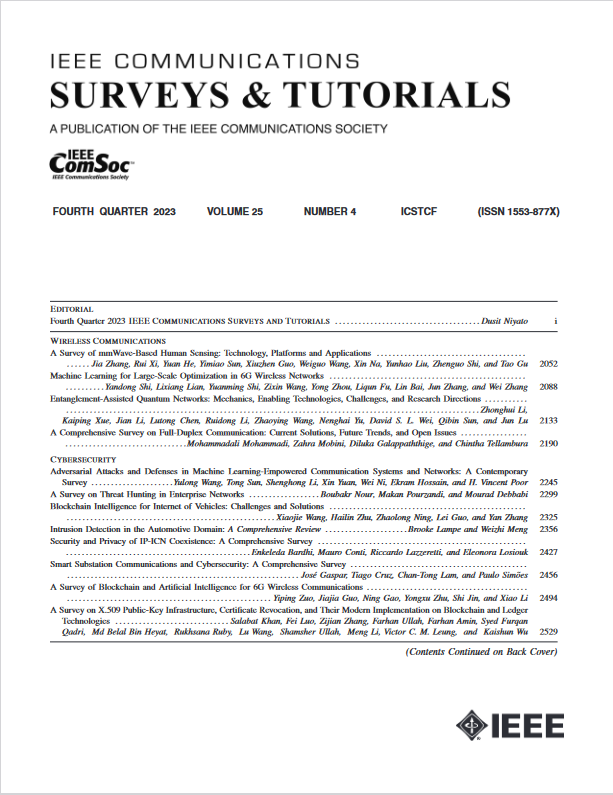下一代多载波通信系统的盲载波频率偏移估计技术:挑战、比较分析和未来展望
IF 34.4
1区 计算机科学
Q1 COMPUTER SCIENCE, INFORMATION SYSTEMS
引用次数: 0
摘要
频率同步对于实现单载波和多载波无线系统的预期性能至关重要。盲技术不需要事先了解信道或导频符号,对于需要自适应同步的动态环境至关重要。本文的一个主要目的是让读者和业界专业人士全面了解正交频分复用(OFDM)、单载波频分多址(SC-FDMA)、多输入多输出(MIMO)-OFDM和MIMO-SC-FDMA等多载波通信系统中的载波频偏(CFO)问题。这些波形用于当今和未来的无线通信系统,如无线保真(Wi-Fi),第五代和第六代。此外,本文还对解决CFO问题的可用解决方案进行了分类。我们研究了最近文献中提出的CFO估计的盲法技术,并给出了潜在的未来方向。总结了用于CFO估算的各种统计方法和深度学习算法,并强调了它们的优点和局限性。我们还结合CFO对下一代无线系统的影响,如正交时频空间和可重构智能表面辅助通信系统,并提供该领域更广泛和更深入的知识。我们提供了一些现有估计器的仿真结果以及它们在均方误差方面的性能比较,以便更好地理解。因此,本文非常适合为盲CFO估计技术提供一个全面的信息源。本文章由计算机程序翻译,如有差异,请以英文原文为准。
Blind Carrier Frequency Offset Estimation Techniques for Next-Generation Multicarrier Communication Systems: Challenges, Comparative Analysis, and Future Prospects
Frequency synchronization is essential to achieving the intended performance for single and multicarrier wireless systems. Blind techniques, which don’t require prior channel knowledge or pilot symbols, are crucial for dynamic environments where self-adaptive synchronization is needed. A key objective of this paper is to provide the readers as well as the industry’s professionals with a comprehensive understanding of the carrier frequency offset (CFO) problem in multicarrier communication systems like orthogonal frequency division multiplexing (OFDM), single carrier-frequency division multiple access (SC-FDMA), multiple input multiple output (MIMO)-OFDM, and MIMO-SC-FDMA. These waveforms are used in today’s and future wireless communication systems such as wireless-fidelity (Wi-Fi), fifth-generation, and sixth-generation. Moreover, this paper also develops a taxonomy of the available solutions to address the CFO issue. We study blind techniques for CFO estimation presented in the recent literature and give potential future directions. We summarize various statistical methods and deep learning algorithms for CFO estimation and emphasize their advantages and limitations. We also incorporate the CFO impact on next-generation wireless systems such as orthogonal time frequency space and reconfigurable intelligent surface-assisted communication systems and provide a broader and deeper knowledge of the area. We provide simulation results of some existing estimators and their performance comparison in terms of mean square error for better understanding. Therefore, this paper is perfectly adapted to provide a comprehensive information source on blind CFO estimation techniques.
求助全文
通过发布文献求助,成功后即可免费获取论文全文。
去求助
来源期刊

IEEE Communications Surveys and Tutorials
COMPUTER SCIENCE, INFORMATION SYSTEMS-TELECOMMUNICATIONS
CiteScore
80.20
自引率
2.50%
发文量
84
审稿时长
6 months
期刊介绍:
IEEE Communications Surveys & Tutorials is an online journal published by the IEEE Communications Society for tutorials and surveys covering all aspects of the communications field. Telecommunications technology is progressing at a rapid pace, and the IEEE Communications Society is committed to providing researchers and other professionals the information and tools to stay abreast. IEEE Communications Surveys and Tutorials focuses on integrating and adding understanding to the existing literature on communications, putting results in context. Whether searching for in-depth information about a familiar area or an introduction into a new area, IEEE Communications Surveys & Tutorials aims to be the premier source of peer-reviewed, comprehensive tutorials and surveys, and pointers to further sources. IEEE Communications Surveys & Tutorials publishes only articles exclusively written for IEEE Communications Surveys & Tutorials and go through a rigorous review process before their publication in the quarterly issues.
A tutorial article in the IEEE Communications Surveys & Tutorials should be designed to help the reader to become familiar with and learn something specific about a chosen topic. In contrast, the term survey, as applied here, is defined to mean a survey of the literature. A survey article in IEEE Communications Surveys & Tutorials should provide a comprehensive review of developments in a selected area, covering its development from its inception to its current state and beyond, and illustrating its development through liberal citations from the literature. Both tutorials and surveys should be tutorial in nature and should be written in a style comprehensible to readers outside the specialty of the article.
 求助内容:
求助内容: 应助结果提醒方式:
应助结果提醒方式:


